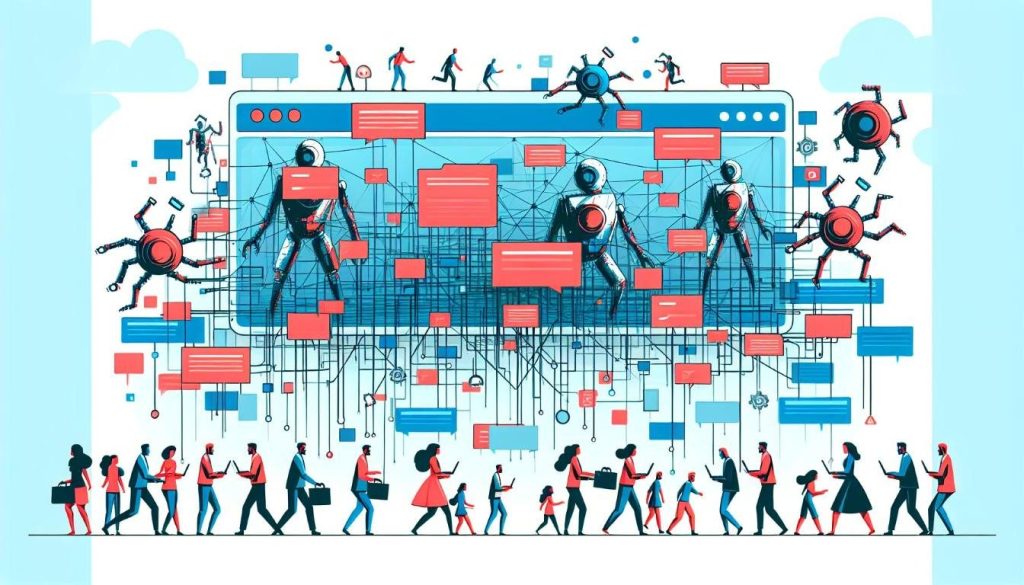AI crawlers are causing significant disruption and prompting protests from developers. As these automated bots increasingly scrape public repositories for data, they are overwhelming infrastructure designed to support collaborative development. The consequences of this aggressive crawling are being felt across numerous platforms, with many developers raising their voices against the impact on their work.
Impact of AI Crawlers on Open-Source Projects
Traffic Displacement
The surge in AI crawlers has led to an alarming displacement of traffic away from genuine users towards automated bots. For instance, according to reports from the GNOME project, around 97% of their traffic was bot-generated during peak times when AI scrapers were active. Such statistics highlight how these bots are not just a nuisance; they significantly skew the user experience and workload for developers working on open-source initiatives.
This traffic displacement doesn’t just affect bandwidth; it also strains server resources. Developers like Drew DeVault of SourceHut have pointed out that persistent bot activity can lead to outages, making their services inaccessible to human users. This situation creates a frustrating cycle where developers must constantly monitor and mitigate the effects of AI crawlers, taking time away from productive coding and project enhancements.
To illustrate the scale of this issue visually:
| Project | % Bot Traffic | Comments |
|---|---|---|
| GNOME | 97% | Severe access issues caused by bots |
| Diaspora | 40% | Noted as significant by developers |
| Fedora (Pagure) | Varied | Blocked entire IP ranges at times |
Developer Concerns
Developers are voicing serious concerns regarding how AI crawlers disregard standard web protocols such as robots.txt files, which traditionally help manage bot access. This disrespect leads to increased operational costs and potential downtime for projects struggling under heavy loads generated by these automated systems.
In discussions among sysadmins, common themes emerge: frustration over constant bot interference and a sense of urgency for solutions. Kevin Fenzi from the Fedora project shared that some teams have taken drastic measures—like banning entire countries—to protect their infrastructures from relentless scraping activities. This type of action highlights not only the desperation felt within these communities but also raises ethical questions about how far one should go to shield valuable resources from abuse.
Statistics and Trends in AI Crawler Traffic
LibreNews Findings
Recent findings reported by LibreNews echo many sentiments expressed by frustrated developers. The publication notes that up to 97% of traffic on certain projects is attributed to bots operated by AI companies. These figures paint a troubling picture: projects initially intended for community collaboration now find themselves under siege from automated systems designed without regard for established norms or guidelines.
This statistic underscores an urgent need within open-source communities for robust countermeasures against AI crawlers that exploit them extensively while contributing little back to those communities themselves.
Comparative Analysis with Human Users
When comparing human traffic versus bot activity, it becomes evident that AI crawlers account for a disproportionate share of web requests across multiple platforms. For example, OpenAI‘s GPTBot alone contributes nearly 25% of requests on some sites — an astonishing figure when considering typical user engagement levels.
To further understand this trend:
- OpenAI’s GPTBot: ~24.6%
- Amazon’s AI crawler: ~14.9%
- Other unidentified scrapers: Significant contributions noted
Many project maintainers have reported similar patterns where human interactions become dwarfed by machine-generated requests, leading them to question whether traditional metrics still apply in evaluating website performance or audience engagement.
Future of Open-Source Infrastructure Amidst AI Crawlers
Potential Solutions for Developers
As open-source projects grapple with overwhelming traffic from AI crawlers, several potential solutions have emerged within developer communities aimed at combating this creeping problem effectively. Some organizations have turned to advanced techniques like Cloudflare’s AI Labyrinth—a system designed not merely to block but actively mislead bots into wasting resources navigating through decoys instead.
By employing deceptive tactics that trap bots in loops or irrelevant content pathways, developers can mitigate some negative impacts without outright denying access—a strategy showing promise as various groups experiment with innovative defenses against incessant scraping.
Furthermore, efforts like creating comprehensive blocklists targeting known offending IPs show tangible results; however, they require continuous updates due to the dynamic nature of crawler behavior continually adapting over time.
Community Responses and Adaptations
The response from the broader developer community has been largely proactive yet varied in approach—some opting for outright bans while others push for collaborative solutions such as establishing new protocols tailored specifically for managing interactions between AI crawlers and open-source repositories.
Developments surrounding legal frameworks offer additional avenues toward resolution; discussions around possible applications of laws such as the Computer Fraud and Abuse Act (CFAA) suggest that legal repercussions could deter companies engaging in non-compliant scraping practices moving forward.
In summary:
- Enhanced defensive strategies like deceiving tactics.
- Legal considerations gaining traction.
- Community-driven initiatives forming collective resistance against intrusive behaviors exhibited by AI crawlers.
Through concerted efforts both technologically and legislatively geared towards safeguarding open-source integrity amid rising challenges posed by automation technologies—open-source advocates may yet reclaim control over their digital environments while fostering collaborative innovation once more undisturbed by relentless bot activity!

